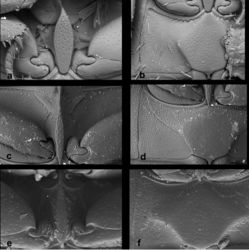Cercyon praetextatus
| Notice: | This page is derived from the original publication listed below, whose author(s) should always be credited. Further contributors may edit and improve the content of this page and, consequently, need to be credited as well (see page history). Any assessment of factual correctness requires a careful review of the original article as well as of subsequent contributions.
If you are uncertain whether your planned contribution is correct or not, we suggest that you use the associated discussion page instead of editing the page directly. This page should be cited as follows (rationale):
Citation formats to copy and paste
BibTeX: @article{Arriaga-Varela2017ZooKeys, RIS/ Endnote: TY - JOUR Wikipedia/ Citizendium: <ref name="Arriaga-Varela2017ZooKeys">{{Citation See also the citation download page at the journal. |
Ordo: Coleoptera
Familia: Hydrophilidae
Genus: Cercyon
Name
Cercyon praetextatus (Say, 1825) – Wikispecies link – Pensoft Profile
- Sphaeridium praetextatum Say, 1825: 190.
- Cercyon praetextatum (Say): Melsheimer, 1853: 37. For complete synonymy see Smetana (1978[1]: 84) and Hansen (1999[2]: 286).
Figures in Flickr
www.flickr.com/photos/142655814@N07/albums/72157669492876764
Type locality
USA, “Cambridge” (based on neotype designated by Smetana 1978[1]).
Greater Antillean specimens studied. CUBA: Santiago de Cuba: Dos Caminos, farm field, MV lights, 20.18043°N, 75.77806°W, 165 m, 23.iii.2013, leg. A. Smith & A. Deler-Hernández (1 spec.: NMPC). Cienfuegos: Cumanayagua municipality, JBC [= Jardín Botánico de Cienfuegos], Soledad, 22°7'18.44"N, 80°19'35.26"W, 3.x.2012, leg. A. Deler-Hernández (1 spec.: NMPC). CAYMAN ISLANDS: Grand Cayman: black-light trap, 17.v.1992, leg. P. Fitzgerald (1 spec.: FSCA). DOMINICAN REPUBLIC: La Vega Prov.: Jarabacoa, 440 m a.s.l., riverside, UV light, 24.vii.-2.viii.1995, leg. S. & J. Peck (3 spec.: CMN). La Ciénega de Manabao, Park Headquarters, 915 m a.s.l. black-light, 3-5.vii.1999, leg. R.E. Woodruff (1 spec.: FSCA).
Published Greater Antillean records
CUBA: Habana Province: Laguna de Ariguanabo (Spangler 1981[3]). JAMAICA: without precise locality (Smetana 1978[1]).
Diagnosis
Body size 2.7–4.1 mm; dorsal surface of head (Fig. 2g) black, with a pair of small reddish-brown spots on vertex, sometimes fused to one spot; pronotum black with sharply defined yellowish to reddish areas at anterolateral corners, sometimes extending to complete lateral margins; elytra black, with large sharply-defined yellowish to reddish-yellow lateroapical area reaching about apical fourth, laterally reaching elytral base in lateralmost interval, yellow spot not extended to humeral area basally; medial ridge of prosternum anteriorly forming a small rounded to slightly pointed process; mesoventral plate (Fig. 13a) wide, ca. 3.3× as long as wide; metaventrite (Fig. 13b) without femoral lines, with narrow raised pentagonal area (ca. as long as wide); first abdominal ventrite without spiniform process in both sexes; apex of fifth ventrite without triangularly bulged projection at apex in both sexes; aedeagus (Fig. 6a–c) with parameres almost twice as long as phallobase, sinuately widened and bearing long setae at apex; median lobe widest at midlegth, narrowing to pointed apex, without spines. For complete description see Smetana (1978)[1].
This species was assigned to the C. marinus group according to Smetana (1978)[1]. By the coloration of pronotum and elytra (Fig. 2g, i), C. praetextatus may be confused with members of the C. gimmeli species group and with C. sklodowskae sp. n. Besides of the features of the aedeagus (Fig. 6a–c), it can be easily distinguished from them by the distinctly wider mesoventral plate (3.3× as long as wide in C. praetextatus, 5.7–5.8× as long as wide in the other species) and the yellow stripe along lateral margin of elytra not expanding basally. Besides of that, females of C. praetextatus lack the triangular projection on the apex of the fifth abdominal ventrite (present in C. sklodowskae), has a very small process of mid-prosternal ridge (large in C. gimmeli species group), and almost straight metatibia (curved in C. gimmeli species group).
Distribution
Cercyon praetextatus is widely distributed in North America (southern Canada, USA, Mexico; Smetana 1978[1]; Ryndevich 2004[4]) and reaches to Central America (Guatemala, Costa Rica; Smetana 1978[1]) and to the Caribbean (Cayman Islands, Cuba, Dominican Republic, Jamaica, Smetana 1978[1], Spangler 1981[3], this paper); it has also been introduced to Argentina (Fikáček 2009[5]). We report it here from Dominican Republic (La Vega Province) and the Cayman Islands for the first time (Fig. 15c).
Biology
This species seems to prefer wet environments, living primarily on many kind of organic debris, like decomposing plant remnants, carrion and dung (Smetana 1978[1]). In Cuba and the Dominican Republic this species has been attracted to light.
Taxon Treatment
- Arriaga-Varela, E; Seidel, M; Deler-Hernández, A; Viktor Senderov, ; Fikáček, M; 2017: A review of the Cercyon Leach (Coleoptera, Hydrophilidae, Sphaeridiinae) of the Greater Antilles ZooKeys, (681): 39-93. doi
Images
|
Other References
- ↑ 1.0 1.1 1.2 1.3 1.4 1.5 1.6 1.7 1.8 Smetana A (1978) Revision of the subfamily Sphaeridiinae of America north of Mexico (Coleoptera: Hydrophilidae). Memoirs of the Entomological Society of Canada 105: 1–292. https://doi.org/10.4039/entm110105fv
- ↑ Hansen M (1999) World Catalogue of Insects 2: Hydrophiloidea (Coleoptera). Apollo Books, Stenstrup, 416 pp.
- ↑ 3.0 3.1 Spangler P (1981) Supplement to the aquatic and semiaquatic Coleoptera of Cuba collected by the biospeleological expeditions to Cuba by the Academies of Science of Cuba and Romania. Résultats des Expéditions Biospéologiques CubanoRoumaines à Cuba 3: 145–171.
- ↑ Ryndevich S (2004) New data on the distribution of American Hydrophilidae (Coleoptera). Latissimus, 18: 11–13.
- ↑ Fikáček M (2009) Occurrence of introduced species of the genus Cercyon (Coleoptera: Hydrophilidae) in the Neotropical Region Revista de la Sociedad Entomológica Argentina 68(3-4): 351–357.



